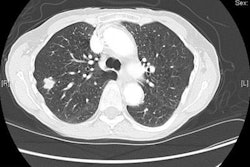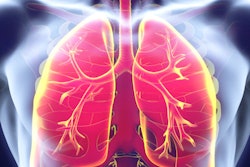Screening patients at high risk of lung cancer with CT can consistently identify early-stage disease in time for a cure, offering a 73% chance of living five years or more when cancer is detected, concluded an important pilot study in the U.K. aimed at assessing the efficacy of CT for lung cancer screening. Results in nearly 2,000 individuals in the pilot study who underwent screening with low-dose CT offers further justification to adopt widespread screening in the U.K.
The just-completed study aimed to analyze the effects of low-dose CT lung cancer screening in a high-risk U.K. population, determine the best recruiting methods and pathways to screening, as well as optimal ways to interpret results and care for patients. The investigators also looked at the psychological effects and economic implications of screening. Among the 42 individuals diagnosed with lung cancer as a result of CT screening in the study, fully 86% were detected at stages 1 and 2, when curative resection is possible.
"This was the first U.K. lung cancer RCT (randomized controlled trial) CT screening trial undertaken in the U.K., which demonstrates that we have a validated method in place to select and recruit individuals with a high risk of developing lung cancer," noted lead author John Field, PhD, professor of molecular oncology (clinical) at the University of Liverpool, in an email. "The health-economic analysis suggests the intervention could be cost-effective but this needs to be confirmed using data on actual lung cancer mortality."
Lung cancer kills more people each year than any other cancer. In the U.K., lung cancer killed more than 35,370 people in 2012 alone, making it the most common cause of cancer death for both men and women.
The U.K. Lung Cancer Screening (UKLS) trial evaluates the concept of a national CT lung cancer screening program based on evidence from the National Institute for Health Research (NIHR) health technology assessment (HTA) program findings that screening intervention could not only be lifesaving, but also cost-effective in individuals at high risk for lung cancer. But the conclusions must be validated with observed lung cancer mortality reduction, the authors wrote (Health Technology Assessment, May 2016, Vol. 20:40, pp. 1-146).
Screening versus usual care
The pilot trial invited more than 247,000 individuals at high risk to undergo lung cancer screening based on risk-stratification criteria, garnering a response rate of 30.7% from the invitations. The study ultimately included 1994 individuals in the CT screening arm and 2027 in the control arm -- all ages 50 to 75 years old and at high risk of lung caner. Participants in the control arm received usual care, meaning they weren't evaluated for lung cancer unless they became symptomatic.
All participants were screened at one of three regional centers with expertise in lung cancer screening, respiratory medicine, pathology, and surgery, including Liverpool Heart and Chest Hospital, Merseyside, and Papworth Hospital, in Cambridgeshire. Screening consisted of a thoracic CT scan and follow-up CT scans as per protocol. Referral to multidisciplinary clinics was determined by nodule size criteria.
Both radiologists and radiographers interpreted CT-detected nodules, which were analyzed volumetrically. The authors measured the prevalence of lung cancer at the baseline, analyzing demographic data including socioeconomic factors affecting participation, and psychological measures including distress and anxiety, depression, decision satisfaction, and cost-effectiveness via modeling.
High lung cancer rate
Among the 1,994 screening participants, 2.1% (n = 42) were diagnosed with lung cancer, including 36 of 42 (85.7%) diagnosed as stage 1 or 2, and 85.6% underwent surgical resection as their primary treatment.
The results provide "further evidence which reinforces that early detection of lung cancer is the way forward," Field told AuntMinnieEurope.com.
Lung cancer was more common in the lowest socioeconomic group, and short-term adverse psychosocial consequences were seen in participants who were randomized to the screening (intervention) arm.
Stress mostly transient
As for the psychological stress of screening, the authors undertook a psychosocial analysis of the UKLS participants through a series of questionnaires.
"Overall transient negative consequences were observed in individuals who were allocated to receive LDCT [low-dose CT] screening and in those who received unfavorable screening results, but these differences resolved over time and were not clinically significant," Field wrote in his email. "However, we did identify a profile of risk factors for non-uptake of the trial, which would need to be considered when introducing a national lung cancer screening program."
Efforts to improve uptake should include strategies for engaging women and targeting high-risk, hard-to-reach groups, including those ages 70 or older, smokers, and those from the poorest areas, he said.
Promising outlook
Yet despite these hurdles, a look at health gains and economics suggests the lung cancer screening intervention could be cost-effective, but will need to be confirmed using data on actual lung cancer mortality, including other screening trials, Field wrote.
"The UKLS trial provides very valuable information for the U.K. National Screening Committee (UKNSC), when considering the implementation of a future national lung cancer CT screening program; however, we await the output from the [Nederlands-Leuvens Longkanker Screenings Onderzoek] NELSON lung cancer screening trial and the pooling of the UKLS and the NELSON to provide mortality data for the UKNSC," he wrote.
The very promising results will inform decisions about whether there should be a screening program, and about how the screening process might be improved, wrote Dr. Stephen Duffy, professor of Cancer Screening within Queen Mary's Wolfson Institute of Preventive Medicine, London, in a statement.
"The UKLS study is a further piece of evidence that low-dose CT in high-risk individuals can save lives," Duffy wrote. "This is particularly relevant in Liverpool where we have one of the highest incidences and mortality rates of lung cancer and the Liverpool Clinical Commissioning Group is actively exploring how it can apply the findings in this study to the benefit of Liverpool through the Healthy Lung Project."



















